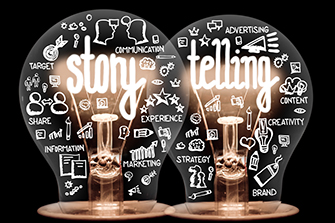
Here’s How Marketers Tell Your Brand’s Story
Marketing Secret: How to Tell Your Brand Story
Every brand has a story. In order for you to reach out to your target audience, you must be able to find them, give them something to relate to you with and have it resonate in a meaningful way. Your brand is more than just a logo and a name. Getting your message across effectively can be challenging. You must find what makes your story unique, learn about your brand attributes, develop a consistent narrative, and stand out from the competition.
The way that marketers accomplish this is by telling your brand’s story, and consistency is the main character. We’re going to let you in on one of our industry’s biggest secrets, and that’s exactly how to tell your brand’s story. Keep reading to learn more about your brand attributes, how to tell a consistent story, and where to find help if you have no idea where to start.
Understanding Brand Attributes
Before we dive into how to tell your brand’s story and build a loyal audience, it’s important to know exactly what your brand’s attributes are. Your brand attributes are going to steer the whole ship—everything from your social media posts to your ads to your major marketing campaigns. Knowing these attributes inside and out is how you’re going to tell a consistent story each and every time, allowing you to build a relatable brand.
Brand attributes include:
- Brand persona
- Brand archetype
- Brand purpose
- Brand plots
These are the characteristics your target audience will come to understand as being the quality, features, and behavior of your brand. They will come to understand them, expect them, and find them comfortable.
Think about McDonald’s for a second. They consistently give you the same product, the same persona, and the same feel-good marketing that you can count on. You know that you will feel the same in any McDonald’s restaurant across the country, leaving them reliable and trusted in your eyes. Let’s get the same thing done for your brand!
Persona
Your brand persona is the personification of your company: How it speaks, its goals, how it presents itself, and more. Some of the ways you can break down your brand’s persona include:
- Tone. Is your brand exciting? Provocative? Urgent? Durable? Nike’s tone is strong and motivating, while Home Depot’s is relatable and reliable. Ask yourself what state people are coming to you in, and set the tone.
- Voice. In order to speak to your target audience, you need to know what language to speak to them in. Are you speaking to moms? CEO’s? Health nuts? People trying to change their lives?
- Personality. Learning how to find your brand’s personality takes empathy mapping in order to dial it in right. Creating a persona of your brand—literally, turning your brand into an actual person with a name, age, background, and everything—will help steer this ship.
Brand Archetype
Your brand archetype is your brand’s human-like character traits that best represent your brand. It uses human psychology to dive deep into building valuable relationships, loyalty, trust, and comfort between you and your customers, and knowing your brand’s archetype can help determine many things when it comes to your marketing.
Your brand archetype will help you determine your brand’s tone and imagery, determining what your target audience is, and what channels to use when marketing. Whether you’re aware of it or not, your brand falls into one of twelve brand archetypes, and knowing which one yours falls into is essential when it comes to crafting an effective marketing strategy.
We wrote a whole blog about brand archetypes that you can dive into here, but you can think of your brand archetype as your brand’s personality and the way it exemplifies itself. Not sure what that is? We’ve broken them down here!
The brand archetypes are:
- The Innocent. Aims to simply make people happy. Example: McDonald’s, Pampers, and Cottonelle
- Everyman. Unpretentious, approachable, and makes people feel comfortable. Example: Home Depot
- Hero. Willing to do anything to overcome an obstacle, exemplifies hard work, and is up for any challenge Example: Nike and Duracell
- Outlaw. Disruptor who rips up the rule book. Example: Tesla
- Explorer. Always seeking fulfillment, excitement, and new challenges. Example: Jeep, NASA
- Creator. You have a huge desire to solve a problem by creating its solution yourself. Example: Apple, GoPro
- Ruler. Your brand is the status quo of your industry; the one people strive to achieve. Example: Rolls Royce, Louis Vuitton
- Magician. You’re a visionary and want to make everyone’s dreams come true. Examples: Disney and Dyson
- Lover. Your brand exudes sexy confidence, romance, and passion. Examples: Victoria’s Secret, Godiva
- Caregiver. There is absolutely nothing in the world more important than taking care of others, and you want to inspire everyone to do the same. Examples: UNICEF, WWF
- Jester. You want people to smile, laugh, and be as light-hearted as possible. Examples: Geico, Old Spice
- Sage. You’re the expert, the scholar, and the one who has already done all the work. Examples: Google, National Geographic
Brand Purpose
Why are you in business? Why do you continue to do what you do? What drives your heart to come to work every day? Here are some things you need in place in order to get your brand purpose squared away:
- Tag line. A tagline is a memorable motto or phrase that’s designed to serve as a permanent expression of your company’s greater purpose and mission. An example of a brand tagline is probably one of the most famous taglines of all: Nike’s “Just Do It.”
- Vision statement. A vision statement is a written declaration clarifying your business’s meaning and purpose for stakeholders, especially employees. An example of a brand’s vision statement is Google’s: “To provide access to the world’s information in one click.”
- Values statement. A values statement lists the core principles that guide and direct the organization and its culture. In a values-led organization, the values create a moral compass for the organization and its employees. A great example of a values statement would be Etsy’s “We commit to our craft.”
Brand Plots
Now’s the time to understand what the plot of your brand’s story is. Remember: Consistency is absolutely key when it comes to brand attributes and telling your story. As such, you want the plot to be the same each and every time.
Which of these brand plots does your brand relate to the most?
- Rags to Riches. Everyone loves a success story! Does your brand completely change people’s lives for the better? Weight Watchers, dentistry, employment recruiters, and more are all great examples of rags-to-riches brand plots.
- Voyage and Return. Think of Alice and Wonderland. The new place she’s forced into is scary but ends up thriving. Now, relate this to your brand, and think of Apple and Steve Jobs, Howard Schulz and Starbucks, and Bob Iger and Disney.
- Rebirth. With Rebirth plot stories, we find our brand develops and transforms. You understand that you may need to pivot with your target audience. Some examples of rebirth brand plot stories include Nintendo, Nokia, and Domino’s.
- Comedy. Is your brand the Jester? Do you love just to make people happy and laugh? Oftentimes, comedy doesn’t have anything to do with the actual brand. Think about Geico: Nothing about home and auto insurance is funny, but they make it comical through their funny commercials, wise-cracking gecko, and more.
- Tragedy. Maybe your brand deals with heavier things that need to be addressed. Someone’s brand has to do it, and it can be yours! Non-profits can often fall into this category.
- Quest. These plots focus on the search for a special item, place, or person, and you help them do it. Amazon, Home Depot, Google, and more are all examples of companies that are dedicated to helping you find exactly what you need when you need it, as easily as possible, and with plenty of options for you to choose from.
- Overcoming the Monster. You and your customers have an antagonist. You overcome it together! Or, maybe your brand is overcoming giants in a David and Goliath type of story. Many Shark Tank brands fall into this category, as well as any brand that is here to help you overcome an obstacle alongside you.
Brand Content
Now that you know who your brand is, what you stand for, and what story you’re telling, you need to craft your brand’s content. Some examples of brand content include:
- Anchor content to reinforce your brand’s concepts. Anchor content is your brand’s first impression and should be absolutely everywhere. Think: Logo, tagline, colors, imagery – all that good stuff.
- Community content to encourage discussion, common interests, values, and purpose is extremely important to tell a relatable brand story. When people see other people just like them enjoying your product or service, it builds trust and loyalty. Obviously, social media is a huge contributor to this version of brand content, as are reviews, events, and the vibe of your storefront (if you have one).
- Archetype content to personify your brand will keep your consistency alive and remind people of who you are and why you’re doing what you’re doing.
- Lifestyle content that expresses how your product and services will fit into your target audience’s life and how they will feel once they have it in their lives. Social media is key to driving this, as is any visual representation of your brand. Imagery is huge here, and testimonials will help keep everything realistic for your target audience.
Telling Your Brand’s Story with Navazon Digital
Ready to tell your brand’s story but not sure where to start? We are experts in that, and we can help you get there.
Navazon helps businesses increase profits through data-driven marketing that expands opportunities and reduces risk. As marketers and entrepreneurs, we understand the value of developing a memorable brand through creativity and consistency. This is accomplished through targeted graphics, videos, and websites that reflect our proven, time-tested methodologies and detailed analytics. It is an approach that’s proven effective for companies of all sizes, from start-ups and medium-sized businesses to large firms with an international presence.
We are content creators who listen to our clients so that we can formulate ideas and strategies based on your unique goals and philosophies. Thinking through those goals with our analytics-based approach, we study not only your tendencies but those of your competition and the market as a whole.
Equipped with this knowledge, we develop a powerful plan, test it and then roll it out on a modest scale. Once we arrive at the winning formula, we can scale up rapidly to meet even the most optimistic growth projections.
At Navazon, we do not believe in “one size fits all.” Every part of the marketing plan is customized to address your unique niche and positioning strategy. It’s how we excel. It’s why we succeed.
Schedule a free consultation with us now! Visit us at navazondigital.com for more information.




